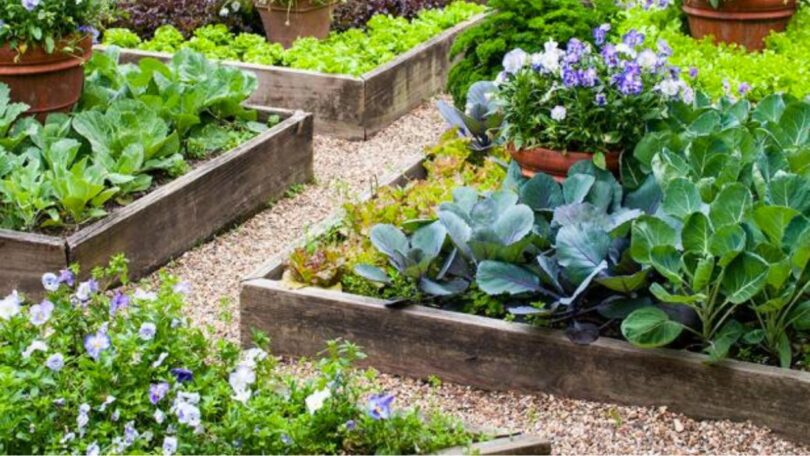1. Choose Your Location
The first step in building raised beds is to choose the location. Look for a spot that receives at least six hours of sunlight per day and has good drainage. Avoid low-lying areas that are prone to flooding.
2. Determine the Size and Shape
Determine the size and shape of your raised beds based on your garden needs and space limitations. Popular sizes are 4'x4', 4'x8', and 3'x6'. The height can range from 6 inches to 2 feet, depending on your preference.
3. Gather Your Materials
Gather your materials, including untreated wood planks, galvanized screws, a saw, a drill, a level, a measuring tape, and weed barrier fabric.
There is one important thing you should consider to have better longevity and durability is choosing the main material for your raised beds. Galvanized raised garden beds will be more durable than others such as wood, vinyl, fabric, etc… but it is not affordable.
4. Build the Frame
Cut the wood planks to the desired length and assemble them into a frame using galvanized screws to secure the corners. Make sure the frame is level by using a level tool. If you're building a larger bed, add support beams in the middle to prevent bowing.
5. Add Weed Barrier Fabric
Lay down weed barrier fabric on the ground inside the frame to prevent weeds from growing up into your raised bed. Cut the fabric to size and staple it to the sides of the frame.
6. Add Soil, Compost, and Worm Castings
Fill the bottom third of the bed with a mixture of topsoil, compost or composted manure. You can also add worm castings, which are especially beneficial.
What are worm castings? Worm castings, also known as vermicompost, are the nutrient-dense waste material worms excrete as they break down organic matter in their digestive systems.
Add layers of the soil, compost, and worm castings until you reach the top of the bed, watering thoroughly after each layer.
For the final layer, fill with a soil, compost, and worm-casting mixture up to 2 inches from the top. This will allow room for the soil to settle and provide space for watering the plants.
The worm castings will help enrich the soil as their high nutrient content and crumbly texture promote plant growth and healthy soil life. Be sure to thoroughly incorporate the castings throughout the soil profile.
7. Plant Your Garden
Now that your raised bed is built and filled with soil, it's time to plant your garden. Choose plants that are suitable for the amount of sunlight and growing conditions in your garden. You can plant directly into the soil or use containers to grow your plants.

FAQs
1. What kind of wood should I use for raised beds?
It's best to use untreated wood for raised beds to avoid any chemicals leaching into your soil. Cedar, cypress, and redwood are good choices as they are naturally resistant to rot and decay.
2. How deep should a raised bed be?
A raised bed should be at least 6 inches deep but can be as deep as 2 feet. The depth will depend on the type of plants you want to grow and their root systems. Deeper beds are better for plants with deep roots such as tomatoes and carrots.
3. Can I use rocks instead of wood for raised beds?
Yes, you can use rocks instead of wood for raised beds. However, keep in mind that rocks can absorb heat and make the soil too hot for some plants. They can also be difficult to work with and may require more effort to build.
4. Can I use cedar for raised garden beds in a wet climate?
Yes, you can use cedar for raised garden beds in a wet climate, but you may need to take some precautions to protect the wood from moisture. The best cedar raised garden bed is applied by a waterproof sealant to the wood to help protect it from moisture, and you can also line the interior of the raised bed with a layer of gravel or sand to help with drainage.
5. Can I build raised beds on a slope?
Yes, you can build raised beds on a slope. However, you may need to terrace the beds to prevent soil erosion. This involves building multiple smaller raised beds on different levels.
6. How do I build a raised garden bed with a trellis?
To build the best trellis raised garden bed with a trellis, you will need to construct the raised bed first, using wooden planks or bricks. Once the raised bed is built, you can add the trellis by attaching it to the sides of the raised bed using screws or nails. You can then train climbing plants, such as tomatoes or cucumbers, to grow up the trellis.
Final Thought
Building the best raised garden beds for your garden is a great way to improve soil quality, drainage, and accessibility. By following these steps, you can build a raised bed that fits your garden needs and space limitations.







